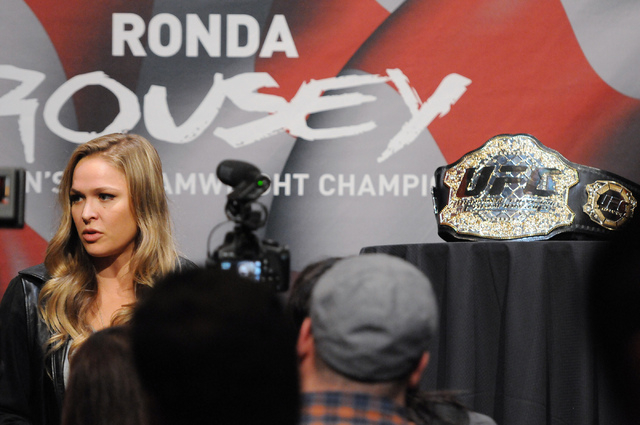UFC fighters won’t profit most from Reebok deal
Think of it as the next step in the journey of strengthening an already conventional identity.
That, and of gaining even more power over those who fight in your cage.
Lorenzo Fertitta has never wavered from this stance: It’s about the brand. He believed it in 2001, when Fertitta told his attorneys the most powerful part about spending $2 million to purchase the Ultimate Fighting Championship were the three letters people most react to.
The UFC has since proved him correct millions of times over.
Years later, signing a companywide apparel contract with Reebok has only placed the UFC more inside those ropes that define mainstream professional sports, the next predictable business move by a company that has made far more good ones than bad.
Which doesn’t necessarily make this most recent deal a great thing for those fighting.
The UFC this week announced a tiered payment system for its athletes from its partnership with Reebok, and if all 586 currently under contract didn’t voice their displeasure across social media, well, a good chunk of them did.
It’s better such payments for wearing Reebok gear during fight week and in the octagon will be determined by one’s tenure with the UFC and not those fighter rankings produced by select media, given the latter is a subjective metric that doesn’t include many of the most legitimate sorts that regularly cover the company.
The rankings aren’t respected, at least not by many who know the sport best.
But while the deal ensures fighters will be handed a paycheck for wearing Reebok, meaning some no longer have to spend time chasing sponsorship dollars promised but not delivered by various companies, the scale severely limits what each can make.
Whether it’s No. 586 or Ronda Rousey.
You might think someone with one to five bouts in the UFC getting paid $2,500 per fight from Reebok seems unfair, until you consider a fighter with six to 10 bouts gets $5,000.
Then you really know things aren’t right.
The scale rises to a maximum of $40,000 for champions, but it’s also true a handful of stars (Rousey being one) have exclusive deals with Reebok that fatten their bank accounts more than the tiered payments.
It’s sports. The best performers always seem to get paid one way or another.
“We’re breaking new ground here,” Fertitta said on a conference call. “This is all new territory for us and the sport.”
Not in every way.
I understand the UFC’s desire for uniformity, for not wanting its fight cards to resemble race week at Talladega. I get why those in charge believe such an apparel deal will place the company in the same light as the NFL and others when it comes to what their athletes wear.
But this also is about the hunger for absolute power and control over those employed, another area in which the UFC has much in common with mainstream leagues. You think Roger Goodell has command over NFL players? It’s nothing compared to the authority those who run the UFC have over fighters.
UFC middleweight Josh Samman wrote an insightful reaction to the Reebok pay scale for bloodyelbow.com, where he addressed the most critical point: Until more sponsorship dollars emerge from promotions such as Bellator or the World Series of Fighting, until a better and financially sweeter option is unearthed, remaining with the UFC and accepting its rules is the optimum choice for fighters.
Just not always a popular one.
It always has been important to Fertitta and UFC president Dana White for their company to be viewed in a mainstream light. It’s huge. Most every decision made has been to better position themselves alongside those who run other globally influential sports. The Reebok deal is just another maneuver.
I’m also certain either doesn’t bemoan the fact the pay scale will greatly diminish the impact of those managers who work to strike the best deals for fighters. Sports executives respect agents as Bob Arum does Al Haymon, which is to say not in the least.
I’m hardly a math major, but it does appear the $70 million agreement needs to be explained a little better by the UFC to support its contention that the majority of revenue from Reebok gear and merchandise will go directly back to the fighters. Many fine details are blurred right now. When it comes to hard numbers, things are a bit obscure.
You hope the fighters benefit in a way Fertitta and White promise, but the UFC over time has been more tight-lipped about compensation for athletes as Tom Brady is about who fiddles with his balls. I’m not against such secrecy in every case, because I’ve never understood why it’s my business or anyone else’s to know what an athlete makes. I am against others fiddling with Brady’s balls before a game, especially if it’s against the Dallas Cowboys.
The tiered system is not entirely a right or wrong issue. While the open market has been shut on fighters who believe they can and have secured more sponsorship dollars for what they wear and how they are marketed, guaranteed cash is nothing to summarily dismiss.
And while the numbers are still far too low in terms of what a fighter should expect, they absolutely fall in line with the journey the UFC has traveled to this point.
Which is to say, this is how big business operates.
This is the part that comes with building a brand to a global level.
Fairness for those competing is rarely a principal objective when negotiations commence.
In other words, it’s about the fighters, until it isn’t.
Las Vegas Review-Journal sports columnist Ed Graney can be reached at egraney@reviewjournal.com or 702-383-4618. He can be heard on “Seat and Ed” on KRLV 1340 from 2 p.m. to 4 p.m. Monday through Friday. Follow him on Twitter: @edgraney.

















